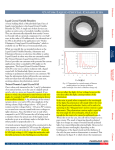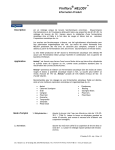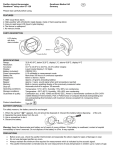Download PLP-052 - Plasma Physics at West Virginia University
Transcript
WEST VIRGINIA UNIVERSITY PLASMA PHYSICS GROUP INTERNAL REPORT PL-052 Sirah Matisse Laser Alignment S. Sears December 2014 Matisse Laser Alignment 1) Follow normal turn on procedures for pump and dye lasers. 2) If not lasing at turn on, rock M1 vertical and horizontal knobs (pull at them) until flash occurs. Once the laser flashes, adjust M1, M3, M4 and thick etalon (TE) micrometers to maximize power. If no lasing continue to step 3. 3) Shutter pump laser and place pinholes on tuning mirrors. At no point during the following procedure should the TE or pump mirror (PM) be adjusted if the laser is not lasing. Adjusting these without lasing can lead to gross misalignment of the cavity, which causes crying, swearing and praying. 4) Open shutter and observe fluorescent spots between TE and TGG crystal. Adjust M4 spot height using target. Using M1 only, place M1 spot so that it completely overlaps M4 spot. 5) Place target between thin etalon (THE) and M4. Using M3 only, overlap M3 spot and M4 spot. 6) Place target between pump mirror and rhomb. Check for overlap of spots, but do not adjust any mirrors. If spots completely overlap proceed to step 6, if not return to steps 4 and repeat until they do. 7) Shutter laser and remove pinholes. 8) Open shutter and observe spots coming out of output coupler (OC), see figure below. 9) Rock M1 vertical and horizontal until flash occurs. Once the laser flashes adjust M1, M3, M4 and TE micrometers to maximize power. If no lasing occurs go back to step 3 and repeat. Cavity alignment is difficult and can take many iterations. 10) If still unable to achieve flash after many cavity alignment iterations it is possible that the TE may be misaligned. If this is the case remove the TE and follow the given directions for out of cavity TE alignment. Tune birefringent filter (BRF) to peak of dye curve. 2 11) With the TE removed place dummy etalon in the cavity where the TE normally sits, see figure below. Try to ensure that the face of the dummy etalon is parallel to the face of the Birefringent Filter. 12) With the dummy etalon in place repeat steps 3 through 9 to align cavity. Check placement of M4 spot on M3. Spot should be in center of mirror. If not walk spot to center of M3 mirror using M4. Align M1 and M3 spots to the M4 beam path using procedure given in steps 3, 4 and 5. Be patient and precise through these steps, it takes many iterations to properly align the cavity. 13) Once cavity is aligned remove dummy etalon and replace aligned TE. Look for “ghost” spots on M1, M3 and M4. Also, check for clipping through TE (this should not occur if the M4 spot on M3 is in the proper position). If clipping is observed, replace dummy etalon and repeat step 12. 14) Overlap “ghost” spots with “normal” spots by twisting and sliding TE assembly. Do not adjust TE alignment knobs as this will destroy the TE alignment. 15) With ghost spots overlapped, rock M1 and M4 horizontal and vertical until flash occurs. Once flash is achieved, mount TE to cavity with mounting screws and get continuous lasing by adjusting M1, M3 and M4. 16) Check TE spots inside cavity to ensure uni-directional lasing. If spots overlap, laser is lasing bi-directionally. Use TE coarse adjustment knobs to separate spots to achieve unidirectional lasing, see figure on page 139 of the Matisse User’s Manual for spot positions. 17) Once lasing uni-directionally, maximize power using M1, M3, M4, TE micrometers and pump mirror. 18) Perform scans, analyze data, get published, graduate. 3
















